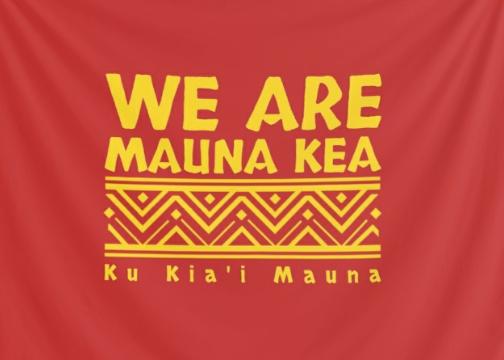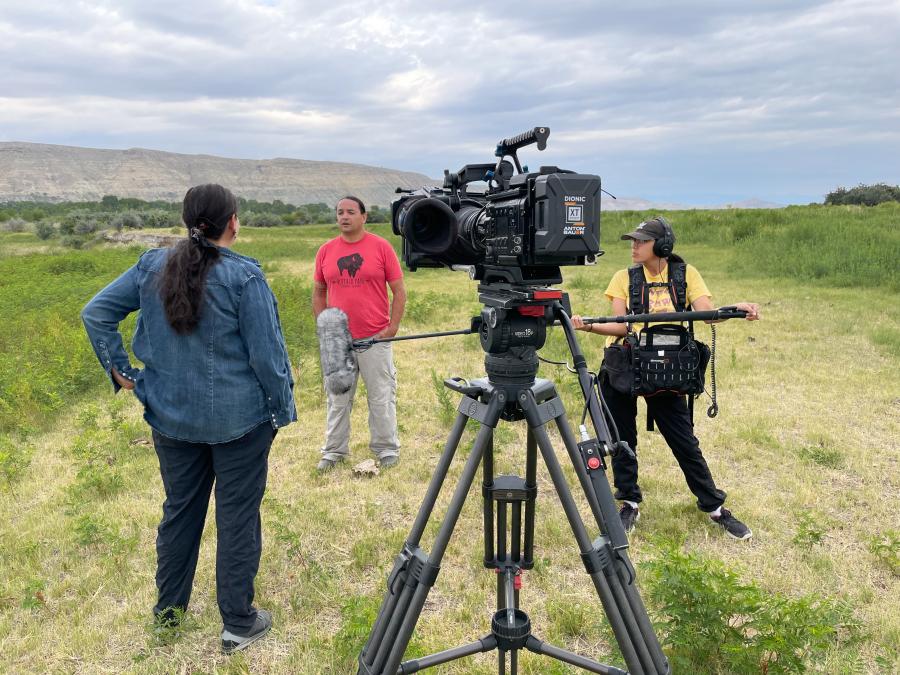
By Chris Swartz
On the island of Hawaii stands the grand Mauna Kea, a dormant volcano that is about one million years old. It stands at 13,803 feet (4,207.3 meters) above sea level, and when measured from its oceanic base, it is 33,000 ft (10,000 m) tall, making it the tallest mountain in the world.
In addition to its geographical significance, Mauna Kea is a site of religious and cultural significance for Kanaka Maoli, or Native Hawaiians. The summit of Mauna Kea is considered to be a wao akua, or “realm of the gods.” Mauna Kea is sacred because it is the piko, or umbilical cord that connects the Creator to the people of Hawai’i. The mountain is also very important to the religious practices of Native Hawaiians because it is the site of many ancient burial sites, sacred spaces, and shrines. Mauna Kea is similar to a temple, where people can pray and make offerings, and also connect spiritually with the heavens and their ancestors. According to tradition, the only people who could go to the summit of the mountain were highly specialized ritual practitioners or people who were completing important rituals. This is no longer respected by society at large, but many Native Hawaiians still honor the religious and cultural practices of their traditions.
The summit of Mauna Kea is also highly regarded by astronomers because of its high elevation, dry environment, and stable air flow. Twenty-two telescopes have been built on the summit since 1964, when the first access road was created.
The United States helped overthrow the Kingdom of Hawai’i in 1893, and annexed Hawai’i as a territory in 1896, and so Native Hawaiians no longer have control over their traditional lands. There has been a long history since then of assimilationist policies enacted by the United States in order to take over complete control of Hawai’i from the Native Hawaiians. Native Hawaiians and their advocates have made progress in removing assimilationist and racist policies, but there are still forms of discrimination that remain, including the lack of respect for Mauna Kea.
Since Hawai’i became a state in 1959, the state government has taken over control of Indigenous land and keeps it as a land trust for the people of Hawai’i, which includes leasing out the summit of Mauna Kea to the University of Hawai’i. However, according to international mechanisms that the United States has adopted, such as the United Nations Declaration on the Rights of Indigenous Peoples (UNDRIP), it is a human rights violation to use Indigenous Peoples’ lands without their free, prior, and informed consent. So while the scientific community has valid reasons to want to use the summit of Mauna Kea for astronomical purposes, they do not have the right to take and use that land without permission. And so Native Hawaiians and their advocates are challenging the construction of the Thirty Meter Telescope (TMT) because consent has not been given.
In 2009, the TMT International Observatory chose the summit of Mauna Kea as the site to build their new telescope, and they were approved for a building permit in 2010 by the Hawai’i Board of Land and Natural Resources. This approval was given without consultation and consent from Native Hawaiians. A group of Native Hawaiians, the Mauna Kea Hui, challenged this and appealed the State agency action to Hawai’i’s judicial appeals court. The court ruled that the Board of Land and Natural Resources was allowed to approve the permit. The Mauna Kea Hui also appealed to the Hawai’i Supreme Court, but TMT continued with their plans for construction.
In October 2014, protesters interrupted the TMT groundbreaking ceremony. Then in April and June of 2015, protesters blocked roads up to the summit and were arrested. The protesters opposed both construction and the lack of respectful, meaningful consultation with Native Hawaiians about the telescope.
In December 2015, the Hawai’i Supreme Court ruled that the 2011 building permit from the Hawai’i Board of Land and Natural Resources (BLNR) was invalid because they approved it before the contested case hearing. The BLNR would need to hold another contested case hearing before issuing any new permits. The hearings were held from 2016 to 2017.
In October 2018, the Hawai’i Supreme Court ruled in favor of the TMT telescope. The court stated that the additional round of contested case hearings served as sufficient due process for Native Hawaiians, and so construction could continue. In addition, the court found that the land was no longer worthy of legal protections because it was too degraded from previous telescope construction work. But the court failed to acknowledge that this degradation occurred during a time where Native Hawaiian language and cultural practices were suppressed in order to promote more development on Mauna Kea. The court’s holding was disrespectful toward the religious rights of Native Hawaiians, suggesting Judge Amano’s earlier ideas that the religious practices taking place on the summit were just tactics to prevent construction.
At the end of 2018, the Office of Maunakea Management and University of Hawai‘i redeveloped the management plan of Mauna Kea, which was updated to limit protesting on the mountain, but it also limits all religious practices. The new plan prevents groups larger than 10 from holding ceremonies, and any ceremony or gathering requires a permit. But to receive a permit, there must be as much as 45 days of advanced notice. Groups could also receive up to $60,000 in fines for four days of protesting. Mauna Kea is land that traditionally belonged to Native Hawaiians, yet this new management plan seems like an attempt to limit the rights of Native Hawaiians.
After the Supreme Court decision, Cultural Survival assisted a coalition of Native Hawaiian organizers to request Early Warning Measures and Urgent Action Procedures by submitting a report on March 22, 2019, to the 98th Session of the Committee on the Elimination of Racial Discrimination (CERD). In addition, Mauna Kea is held by the Hawaiian government as public trust land, and under CERD article 5 (d) (vi), Native Hawaiians have the right to inherit.
On July 14, 2019, Cultural Survival sent an urgent update to CERD, describing the discriminatory actions the Hawaiian government was taking against Native Hawaiians. At the end of June 2019, the State of Hawai’i purposefully destroyed religious structures built by Native Hawaiians. It also announced that the way was clear to begin construction, the mountain would be closed to Native Hawaiians, and all protesters would be arrested.
Construction was scheduled to begin on July 15, 2019, and protectors began to gather at Mauna Kea. On July 17, the Governor of Hawai’i, David Ige, issued an emergency proclamation after a day of protectors blocking access to the roads. Thirty three kūpuna, or elders, were arrested. Protectors continued to gather, and over the course of the week, numbers grew from 500 to 2,000. Representatives from Indigenous Nations around the globe have also been arriving in support and solidarity, much like what occurred during the the NODAPL fight at Standing Rock. On July 21, over 1,000 Hawaiians marched in Waikiki in opposition to the construction of the TMT telescope. Actors Dwayne “The Rock” Johnson, who is Samoan, and Jason Momoa, who is Native Hawaiian, have also visited Mauna Kea to show their support for the protectors.
Presley Keʻalaanuhea Ah Mook Sang, a Hawaiian language professor at the University of Hawai’i at Manoa has started a Hawaiian and community led school, Pu’u Honua o Pu’uhuluhulu University. There are classes on a variety of subjects, including Indigenous rights and history. The school was established less than a week after July 15, and has grown to include classes taught by a range of educators including some of the elders who were arrested on July 17. Noelani Puniwai, an assistant professor at the University of Hawai’i, taught a class called Climate Change. She said that the classes at Pu’uhuluhulu are different from the traditional university setting, they’re more like “an exchange” between teacher and student.
On July 30, Governor Ige rescinded his emergency proclamation. The Hawai’i Department of Land and Natural Resources has also approved a two year extension for the project, pushing construction back to September 2021.
In an interview with Indigenous Rights Radio, the Native Hawaiian activist, Pua Case, revealed that the TMT will be built on “a mountain that can still shake. A mountain that still teaches and speaks to us. A mountain that we hold as a temple, as a sanctuary, as a sacred place. We stand because of that. We stand because don’t you think that at some point in time a native people and their supporters and their allies and their friends have the responsibility, the birthright, and the privilege to say no. Enough is enough. You have taken so much of what we already have that we are standing to say a’ole – no.”



